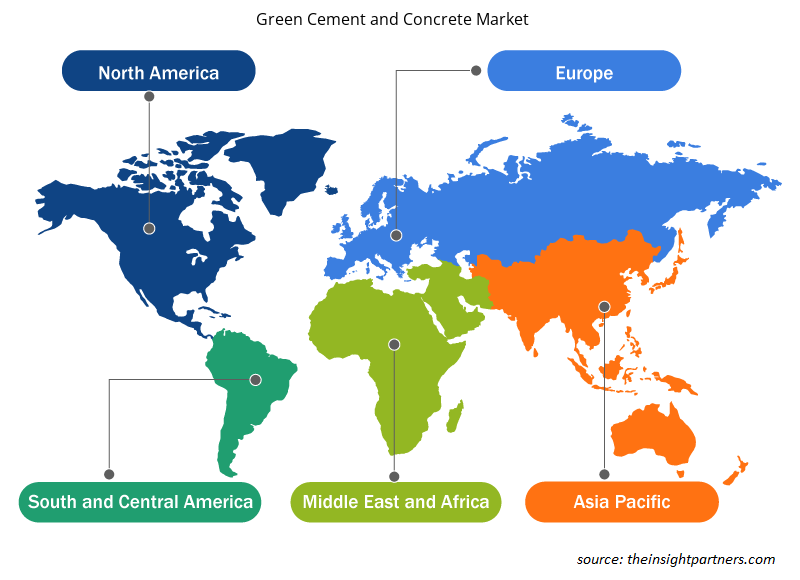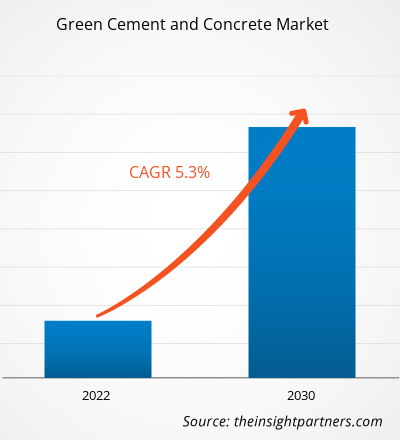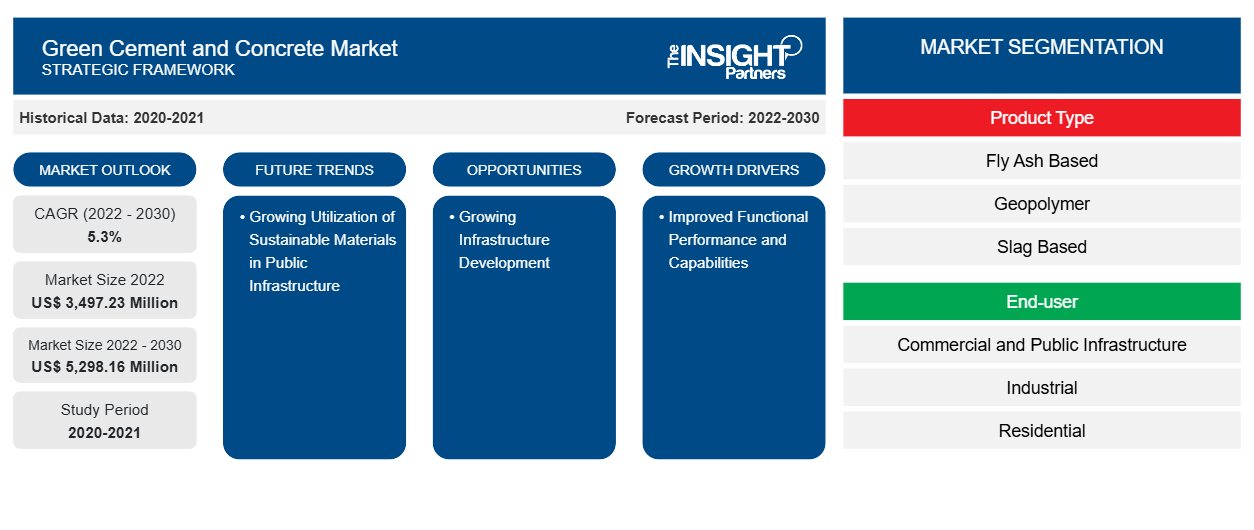La taille du marché du ciment et du béton verts devrait atteindre 5 298,16 millions USD d’ici 2030, contre 3 497,23 millions USD en 2022. Le marché devrait enregistrer un TCAC de 5,3 % en 2022-2030. De nombreux pays mettent en œuvre des feuilles de route pour la décarbonisation de l’industrie du ciment, ce qui stimule la demande de ciment et de béton verts à l’échelle mondiale.
Analyse du marché du ciment et du béton verts
L'industrie du ciment est l'une des principales industries axées sur le carbone, ce qui devrait avoir un impact négatif sur la protection de l'environnement. Ainsi, la préoccupation croissante envers l'atténuation de l'impact du carbone sur l'environnement et l'accent mis sur l'augmentation des approches de durabilité devraient stimuler la croissance du marché mondial du ciment et du béton verts .
Aperçu du marché du ciment et du béton verts
L'initiative croissante du gouvernement et les politiques encourageantes devraient stimuler l'intégration du ciment et du béton verts durables dans les fondations des infrastructures publiques. Par exemple, plusieurs projets d'infrastructures à venir en Inde, tels que le projet de développement de la vallée de Narmada, Bharatmala Pariyojana, le pont ferroviaire de la rivière Chenab, la liaison trans-portuaire de Mumbai, le corridor industriel du métro de Delhi et le projet international Navi Mumbai, devraient être construits en utilisant du ciment et du béton verts. Ainsi, la prolifération croissante du ciment vert comme alternative viable au ciment conventionnel devrait maintenir son application croissante dans le secteur des infrastructures commerciales et publiques.
Personnalisez ce rapport en fonction de vos besoins
Vous bénéficierez d'une personnalisation gratuite de n'importe quel rapport, y compris de certaines parties de ce rapport, d'une analyse au niveau des pays, d'un pack de données Excel, ainsi que de superbes offres et réductions pour les start-ups et les universités.
- Obtenez les principales tendances clés du marché de ce rapport.Cet échantillon GRATUIT comprendra une analyse de données, allant des tendances du marché aux estimations et prévisions.
Moteurs et opportunités du marché du ciment et du béton verts
L'amélioration des performances et des capacités fonctionnelles stimule la demande de ciment et de béton verts
Le processus de fabrication du ciment standard nécessite une grande quantité de gaz naturel à des fins de chauffage. Le ciment vert est fabriqué à partir de sous-produits industriels, ce qui rend le processus de production plus économe en énergie. Le ciment vert présente une meilleure résistance au feu et prend moins de temps de prise que les autres ciments standard. Les constructions construites avec du ciment vert ont une durée de vie plus longue. Le processus de fabrication du ciment vert suit des techniques haut de gamme qui peuvent réduire les rejets de carbone, provoquant ainsi une pollution minimale. La production de ciment vert nécessite l'application de sous-produits, tels que les scories de haut fourneau, la silice de cendres volantes et le fer, qui sont rentables. Le ciment vert possède 0,5 à 0,6 % de dioxyde de fer dans ses propriétés, ce qui confère de la force à la solidité et à la couleur du ciment. Ce ciment sèche rapidement et a un taux de retrait minimal. Il dure plus longtemps et constitue une alternative plus durable pour l'environnement. Le ciment vert offre également une isolation thermique et une résistance au feu haut de gamme. Le ciment vert est une alternative plus adaptée aux zones à fort trafic telles que les routes, les ponts et les aéroports, car il peut supporter de lourdes charges. Ainsi, le niveau de performance et les capacités supérieures du ciment vert en termes de durabilité, de solidité et de résistance propulsent le marché.
Développement croissant des infrastructures – Une opportunité sur le marché du ciment et du béton verts
L’augmentation du financement des infrastructures durables ouvre la voie à des opportunités de ciment et de béton verts, en stimulant l’utilisation d’alternatives respectueuses de l’environnement et en encourageant le développement économique. Elle offre également aux pays la possibilité d’intégrer le développement de leurs infrastructures et leurs objectifs climatiques en participant à des projets qui réduisent la présence de carbone, notamment des écosystèmes de construction et de fabrication durables et écologiques. Le secteur de la construction et des infrastructures se concentre sur la réduction de son empreinte carbone, car il est le principal contributeur à la pollution de l’environnement. Ainsi, l’accent croissant mis sur le ciment et le béton verts dans le développement des infrastructures devrait offrir de grandes opportunités pour le marché.
Analyse de segmentation du rapport sur le marché du ciment et du béton verts
Les segments clés qui ont contribué à l’élaboration de l’analyse du marché du ciment et du béton verts sont le type de produit et l’utilisateur final.
- En fonction du type de produit, le marché du ciment et du béton verts a été divisé en deux catégories : à base de cendres volantes, géopolymère, à base de scories et autres. Le segment à base de cendres volantes détenait une part de marché plus importante en 2022.
- En fonction de l'utilisateur final, le marché du ciment et du béton verts a été divisé en infrastructures commerciales et publiques, industrielles et résidentielles. Le segment des infrastructures commerciales et publiques détenait une part de marché plus importante en 2022.
Analyse des parts de marché du ciment et du béton verts par zone géographique
La portée géographique du rapport sur le marché du ciment et du béton verts est principalement divisée en cinq régions : Amérique du Nord, Asie-Pacifique, Europe, Moyen-Orient et Afrique, et Amérique du Sud/Amérique du Sud et centrale.
Les préoccupations environnementales croissantes et l'accent mis sur l'utilisation d'alternatives durables dans l'industrie du ciment stimulent la croissance du marché du ciment et du béton verts en Asie-Pacifique. Des pays comme la Chine et l'Inde, principaux producteurs de ciment, ont identifié la nécessité de passer à des pratiques de production de ciment plus respectueuses de l'environnement. En outre, les gouvernements de divers pays prennent diverses mesures pour attirer des financements privés dans les projets de développement des infrastructures. L'augmentation des investissements dans les projets de construction résidentielle et commerciale stimule la demande de matériaux de construction avancés, notamment de solutions de ciment et de béton verts , dans les pays d'Asie-Pacifique.
Aperçu régional du marché du ciment et du béton verts
Les tendances et facteurs régionaux influençant le marché du ciment et du béton verts tout au long de la période de prévision ont été expliqués en détail par les analystes d’Insight Partners. Cette section traite également des segments et de la géographie du marché du ciment et du béton verts en Amérique du Nord, en Europe, en Asie-Pacifique, au Moyen-Orient et en Afrique, ainsi qu’en Amérique du Sud et en Amérique centrale.

- Obtenez les données régionales spécifiques au marché du ciment et du béton verts
Portée du rapport sur le marché du ciment et du béton verts
| Attribut de rapport | Détails |
|---|---|
| Taille du marché en 2022 | 3 497,23 millions de dollars américains |
| Taille du marché d'ici 2030 | 5 298,16 millions de dollars américains |
| Taux de croissance annuel moyen mondial (2022-2030) | 5,3% |
| Données historiques | 2020-2021 |
| Période de prévision | 2022-2030 |
| Segments couverts | Par type de produit
|
| Régions et pays couverts | Amérique du Nord
|
| Leaders du marché et profils d'entreprises clés |
|
Densité des acteurs du marché du ciment et du béton vert : comprendre son impact sur la dynamique des entreprises
Le marché du ciment et du béton verts connaît une croissance rapide, tirée par la demande croissante des utilisateurs finaux en raison de facteurs tels que l'évolution des préférences des consommateurs, les avancées technologiques et une plus grande sensibilisation aux avantages du produit. À mesure que la demande augmente, les entreprises élargissent leurs offres, innovent pour répondre aux besoins des consommateurs et capitalisent sur les tendances émergentes, ce qui alimente davantage la croissance du marché.
La densité des acteurs du marché fait référence à la répartition des entreprises ou des sociétés opérant sur un marché ou un secteur particulier. Elle indique le nombre de concurrents (acteurs du marché) présents sur un marché donné par rapport à sa taille ou à sa valeur marchande totale.
Les principales entreprises opérant sur le marché du ciment et du béton verts sont :
- Ciment ACC (Groupe Adani)
- Société nationale de matériaux de construction de Chine (CNBM)
- Ciment Vert Inc.
- Ciment de conque d'Anhui
- Holcim Ltée.
- JSW Cement Limited
Avis de non-responsabilité : les sociétés répertoriées ci-dessus ne sont pas classées dans un ordre particulier.

- Obtenez un aperçu des principaux acteurs du marché du ciment et du béton verts
Actualités et développements récents du marché du ciment et du béton verts
Le marché du ciment et du béton verts est évalué en collectant des données qualitatives et quantitatives après des recherches primaires et secondaires, qui comprennent des publications d'entreprise importantes, des données d'association et des bases de données. Voici une liste des développements sur le marché des innovations, de l'expansion commerciale et des stratégies :
- En février 2023, Holcim a lancé la première opération européenne de ciment à base d'argile calcinée dans son usine de Saint-Pierre-la-Cour en France, pour fournir du ciment vert ECOPlanet dont l'empreinte CO2 est inférieure de 50 % à celle du ciment standard (CEM I). (Source : Holcim Ltd., Communiqué de presse/Site Internet de la société/Newsletter)
- En septembre 2023, Hoffmann Green Cement Technologies a signé un accord de partenariat avec Point. P. Selon les termes de l'accord, les produits de ciment sans clinker de HGCT sont distribués aux usines de béton prêt à l'emploi (RMC) et de mélange de Point. P. (Source : Hoffmann Green Cement Technologies, communiqué de presse/site Web de l'entreprise/bulletin d'information)
Rapport sur le marché du ciment et du béton verts : couverture et livrables
Le rapport « Taille et prévisions du marché du ciment et du béton verts (2020-2030) » fournit une analyse détaillée du marché couvrant les domaines suivants :
- Taille et prévisions du marché du ciment et du béton verts aux niveaux mondial, régional et national pour tous les segments de marché clés couverts par le périmètre
- Dynamique du marché, comme les facteurs moteurs, les contraintes et les opportunités clés
- Tendances du marché du ciment et du béton verts
- Analyse PEST et SWOT détaillée
- Analyse du marché du ciment et du béton verts couvrant les principales tendances du marché, le cadre mondial et régional, les principaux acteurs, les réglementations et les développements récents du marché
- Industrie du ciment et du béton verts, analyse du paysage et de la concurrence, couvrant la concentration du marché, l'analyse de la carte thermique, les principaux acteurs et les développements récents
- Profils d'entreprise détaillés
- Analyse historique (2 ans), année de base, prévision (7 ans) avec TCAC
- Analyse PEST et SWOT
- Taille du marché Valeur / Volume - Mondial, Régional, Pays
- Industrie et paysage concurrentiel
- Ensemble de données Excel
Rapports récents
Rapports connexes
Témoignages
Raison d'acheter
- Prise de décision éclairée
- Compréhension de la dynamique du marché
- Analyse concurrentielle
- Connaissances clients
- Prévisions de marché
- Atténuation des risques
- Planification stratégique
- Justification des investissements
- Identification des marchés émergents
- Amélioration des stratégies marketing
- Amélioration de l'efficacité opérationnelle
- Alignement sur les tendances réglementaires























 Obtenez un échantillon gratuit pour - Marché du ciment et du béton verts
Obtenez un échantillon gratuit pour - Marché du ciment et du béton verts